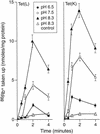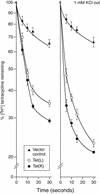Tet(L) and tet(K) tetracycline-divalent metal/H+ antiporters: characterization of multiple catalytic modes and a mutagenesis approach to differences in their efflux substrate and coupling ion preferences
- PMID: 12169596
- PMCID: PMC135290
- DOI: 10.1128/JB.184.17.4722-4732.2002
Tet(L) and tet(K) tetracycline-divalent metal/H+ antiporters: characterization of multiple catalytic modes and a mutagenesis approach to differences in their efflux substrate and coupling ion preferences
Abstract
The Tet(L) protein encoded in the Bacillus subtilis chromosome and the closely related Tet(K) protein from Staphylococcus aureus plasmids are multifunctional antiporters that have three cytoplasmic efflux substrates: a tetracycline-divalent metal (TC-Me(2+)) complex that bears a net single positive charge, Na+, and K+. Tet(L) and Tet(K) had been shown to couple efflux of each of these substrates to influx of H+ as the coupling ion. In this study, competitive cross-inhibition between K+ and other cytoplasmic efflux substrates was demonstrated. Tet(L) and Tet(K) had also been shown to use K+ as an alternate coupling ion in support of Na+ or K+ efflux. Here they were shown to couple TC-Me(2+) efflux to K+ uptake as well, exhibiting greater use of K+ as a coupling ion as the external pH increased. The substrate and coupling ion preferences of the two Tet proteins differed, especially in the higher preference of Tet(K) than Tet(L) for K+, both as a cytoplasmic efflux substrate and as an external coupling ion. Site-directed mutagenesis was employed to test the hypothesis that some feature of the putative "antiporter motif," motif C, of Tet proteins would be involved in these characteristic preferences. Mutation of the A157 in Tet(L) to a hydroxyamino acid resulted in a more Tet(K)-like K+ preference both as coupling ion and efflux substrate. A reciprocal S157A mutant of Tet(K) exhibited reduced K+ preference. Competitive inhibition among substrates and the parallel effects of the single mutation upon K+ preference, as both an efflux substrate and coupling ion, are compatible with a model in which a single translocation pathway through the Tet(L) and Tet(K) transporters is used both for the cytoplasmic efflux substrates and for the coupling ions, in an alternating fashion. However, the effects of the A157 and other mutations of Tet(L) indicate that even if there are a shared binding site and translocation pathway, some elements of that pathway are used by all substrates and others are important only for particular substrates.
Figures






Similar articles
-
Functions of tetracycline efflux proteins that do not involve tetracycline.J Mol Microbiol Biotechnol. 2001 Apr;3(2):237-46. J Mol Microbiol Biotechnol. 2001. PMID: 11321579 Review.
-
Site-directed mutagenesis studies of selected motif and charged residues and of cysteines of the multifunctional tetracycline efflux protein Tet(L).J Bacteriol. 2002 Mar;184(6):1796-800. doi: 10.1128/JB.184.6.1796-1800.2002. J Bacteriol. 2002. PMID: 11872735 Free PMC article.
-
Twelve-transmembrane-segment (TMS) version (DeltaTMS VII-VIII) of the 14-TMS Tet(L) antibiotic resistance protein retains monovalent cation transport modes but lacks tetracycline efflux capacity.J Bacteriol. 2001 Apr;183(8):2667-71. doi: 10.1128/JB.183.8.2667-2671.2001. J Bacteriol. 2001. PMID: 11274128 Free PMC article.
-
Importance of the GP dipeptide of the antiporter motif and other membrane-embedded proline and glycine residues in tetracycline efflux protein Tet(L).Biochemistry. 2005 Sep 27;44(38):12896-904. doi: 10.1021/bi050762c. Biochemistry. 2005. PMID: 16171405 Free PMC article.
-
Precious things come in little packages.J Mol Microbiol Biotechnol. 2001 Apr;3(2):155-62. J Mol Microbiol Biotechnol. 2001. PMID: 11321568 Review.
Cited by
-
"Drug resistance associated membrane proteins".Front Physiol. 2014 Mar 20;5:108. doi: 10.3389/fphys.2014.00108. eCollection 2014. Front Physiol. 2014. PMID: 24688472 Free PMC article. No abstract available.
-
Identification, cloning, and functional characterization of EmrD-3, a putative multidrug efflux pump of the major facilitator superfamily from Vibrio cholerae O395.Arch Microbiol. 2009 Dec;191(12):903-11. doi: 10.1007/s00203-009-0521-8. Epub 2009 Oct 30. Arch Microbiol. 2009. PMID: 19876617 Free PMC article.
-
Alkaline pH homeostasis in bacteria: new insights.Biochim Biophys Acta. 2005 Nov 30;1717(2):67-88. doi: 10.1016/j.bbamem.2005.09.010. Epub 2005 Sep 26. Biochim Biophys Acta. 2005. PMID: 16277975 Free PMC article. Review.
-
Multidrug resistance protein MdtM adds to the repertoire of antiporters involved in alkaline pH homeostasis in Escherichia coli.BMC Microbiol. 2013 May 23;13:113. doi: 10.1186/1471-2180-13-113. BMC Microbiol. 2013. PMID: 23701827 Free PMC article.
-
Biochemistry of bacterial multidrug efflux pumps.Int J Mol Sci. 2012;13(4):4484-4495. doi: 10.3390/ijms13044484. Epub 2012 Apr 10. Int J Mol Sci. 2012. PMID: 22605991 Free PMC article. Review.
References
-
- Blostein, R., A. Wilczynska, S. J. D. Karlish, J. M. Arguello, and J. B. Lingrel. 1999. Evidence that Ser775 in the alpha subunit of the Na,K-ATPase is a residue in the cation binding pocket. J. Biol. Chem. 272:24987-24993. - PubMed
-
- Cheng, J., A. A. Guffanti, and T. A. Krulwich. 1994. The chromosomal tetracycline resistance locus of Bacillus subtilis encodes a Na+/H+ antiporter that is physiologically important at elevated pH. J. Biol. Chem. 269:27365-27371. - PubMed
Publication types
MeSH terms
Substances
Grants and funding
LinkOut - more resources
Full Text Sources

